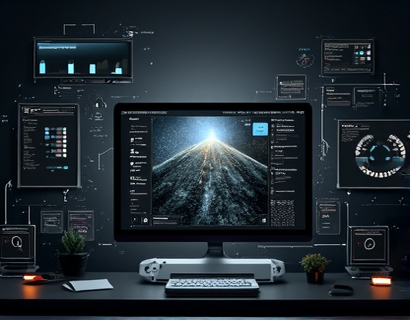Maximizing Civic Engagement: Leveraging Real-Time Data for Transparent Governance
In the digital age, the intersection of technology and governance has opened new avenues for civic engagement. Real-time data access stands as a pivotal tool in transforming how governments operate and how citizens participate in the democratic process. This article delves into the transformative impact of real-time data on governance, emphasizing how open data initiatives drive informed citizen participation and enhance accountability in democratic processes.
The concept of open data in governance is not new, but its implementation through real-time data platforms has revolutionized the way information is shared and utilized. Open data initiatives aim to make government data freely available to the public, unrestricted by copyright, patents, or other mechanisms of control. When this data is presented in real-time, it provides an immediate and dynamic view of government operations, policies, and services. This transparency is crucial for fostering a more informed and engaged citizenry.
Real-Time Data: A Game Changer for Transparency
Real-time data offers a unique advantage over traditional data reporting methods. It provides up-to-the-minute insights into various aspects of government functioning, from budget allocations and public spending to environmental monitoring and public health metrics. This immediacy ensures that citizens have access to the most current information, enabling them to make informed decisions and hold authorities accountable.
The impact of real-time data on transparency is profound. By breaking down the barriers of time and access, real-time data platforms democratize information that was once confined to periodic reports or specialized databases. For instance, real-time traffic data can help citizens plan their commutes more efficiently, while real-time public transportation updates can reduce wait times and improve service reliability. These examples illustrate how real-time data can enhance the quality of daily life and foster a sense of trust between citizens and government.
Enhancing Civic Participation through Open Access
Open access to government data is a cornerstone of civic engagement. When citizens can freely access and analyze data, they are better equipped to participate in the democratic process. This access empowers individuals to identify issues, propose solutions, and collaborate with others to drive change. Real-time data platforms facilitate this process by providing a constant stream of information that can be monitored and discussed in real time.
One of the most significant benefits of open access is the promotion of informed debate and decision-making. Citizens can track the progress of policy initiatives, evaluate the effectiveness of government programs, and provide feedback based on current data. This two-way communication loop enhances the responsiveness of government and ensures that policies reflect the needs and preferences of the population.
Case Studies: Successful Real-Time Data Initiatives
Several cities and countries have successfully implemented real-time data initiatives that have transformed civic engagement. For example, New York City's OpenDataNYC platform offers a comprehensive repository of city data, covering areas such as crime statistics, budget expenditures, and environmental quality. This platform has been instrumental in fostering a culture of transparency and has led to numerous civic projects and applications that leverage this data to improve urban life.
Another notable example is Barcelona's Open Data portal, which provides real-time data on various city services, including public transportation, waste management, and energy consumption. The portal has not only increased transparency but has also spurred innovation, with developers creating apps and tools that help citizens navigate the city more efficiently and sustainably.
Building a Collaborative Governance Model
The integration of real-time data into governance is not just about providing information; it is about building a collaborative relationship between the government and its citizens. This collaborative model relies on the principles of openness, participation, and accountability. Real-time data platforms serve as a bridge, connecting government actions with citizen needs and expectations.
By engaging citizens in the data-driven decision-making process, governments can tap into a wealth of local knowledge and expertise. This collaboration can lead to more effective and tailored solutions to community issues. For instance, real-time data on traffic congestion can be used by both government agencies and citizens to develop strategies for reducing traffic, such as optimizing traffic signals or promoting alternative transportation modes.
Challenges and Solutions in Implementing Real-Time Data
Despite the numerous benefits, the implementation of real-time data initiatives faces several challenges. One of the primary concerns is data quality and accuracy. Ensuring that the data provided is reliable and up-to-date requires robust data management systems and continuous monitoring. Governments must invest in technology and personnel to maintain high standards of data integrity.
Another challenge is the digital divide, where not all citizens have equal access to the internet and digital tools. To address this, governments should focus on expanding digital infrastructure and providing training programs to ensure that all citizens can benefit from open data initiatives. Public access points, such as libraries and community centers, can play a crucial role in bridging this gap.
Fostering a Culture of Transparency
Real-time data is a powerful tool for fostering a culture of transparency in governance. Transparency is essential for building trust between citizens and government. When citizens can see how decisions are made and how resources are allocated, they are more likely to trust that their government is acting in their best interests.
Transparency also extends to the governance process itself. Real-time data can be used to track the progress of legislative proposals, budget implementations, and public service deliveries. This visibility holds elected officials accountable and ensures that they remain responsive to the needs of the population. By making the inner workings of government more visible, real-time data helps to reduce corruption and inefficiency.
Encouraging Citizen Participation
Real-time data platforms can be designed to encourage active citizen participation. Interactive features such as data visualizations, forums, and feedback mechanisms allow citizens to engage directly with government data. For example, a real-time budget tracking tool can enable citizens to see how funds are being spent and suggest alternative allocations. This level of engagement not only increases public interest in governance but also leads to more informed and effective civic participation.
Moreover, real-time data can facilitate grassroots movements and community initiatives. By providing access to relevant data, citizens can identify local issues and mobilize support for change. For instance, real-time air quality data can spark community efforts to reduce pollution, while real-time public health data can inform local health campaigns.
The Future of Real-Time Governance
As technology continues to evolve, the potential for real-time data in governance will only grow. Emerging technologies such as the Internet of Things (IoT), artificial intelligence, and blockchain offer new ways to collect, process, and secure data. These advancements can further enhance the capabilities of real-time data platforms, making them more robust, secure, and user-friendly.
Looking ahead, the integration of real-time data with citizen feedback mechanisms will create a more dynamic and responsive governance model. Governments can use AI to analyze large datasets and identify trends, while citizen feedback can provide context and insights that machines cannot. This synergy will lead to more data-driven and citizen-centric policies.
Conclusion
The adoption of real-time data in governance represents a significant step towards more transparent, accountable, and participatory democracy. By leveraging real-time data, governments can enhance transparency, foster civic engagement, and build trust with their citizens. As more cities and countries embrace open data initiatives, the global landscape of governance is poised for a transformative shift. Joining this movement means embracing a future where information is power, and every citizen has the tools to contribute to a better society.










































